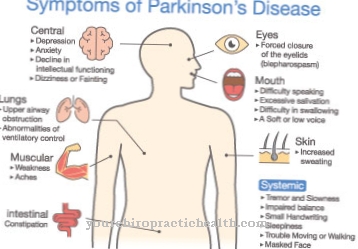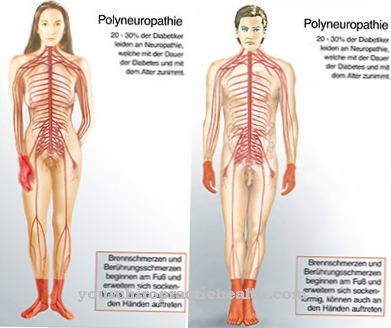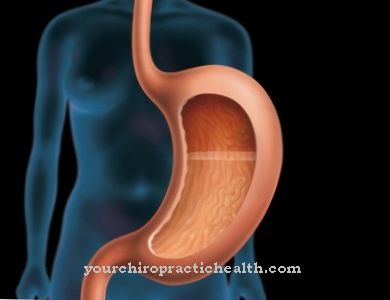The Avulsion fracture is a special type of fracture and is also called Avulsion fracture or bony tendon avulsion designated. Avulsion fractures on the outer knuckle and on the fingers are particularly common.
What is an avulsion fracture?

It is a bone fracture in the area of tendons and ligaments, in which a bone fragment is torn out of the bone by a strong pull of a tendon anchored in the bone. Athletes such as soccer players or skiers are particularly often affected, since in these sports the ankle joint, which is susceptible to avulsion fractures, is subject to greater stress.
The end joints of the fingers are also very often affected. Bony tears in this area occur mainly when doing household chores such as pulling up bedsheets. Because of this, the avulsion fracture in the area of the fingers has also been nicknamed "housewife's finger".
causes
An avulsion fracture occurs through the action of a mechanism by which there is a sudden increase in tension in a tendon or ligament anchored to the bone. A piece of the bone, i.e. a fragment of it, is then torn out of the bone by the strong pull.
The torn out bone fragment can be of different sizes. It can be a small, flat piece made up of a bark-like outer layer of bone. Then it is a torn off of a so-called cortical shell.
However, depending on the type and condition of the affected bone, a larger fragment can be torn out. The fact that in such a case the tendon or ligament itself does not tear is due to the fact that the substance of the tendons and ligaments is very resistant. This does not apply equally to the bone substance.
Compared to intact tendons and ligaments, bones are less strong. In particular, tendons and ligaments can react much better to a sudden change in tension because, in contrast to bones, they are more flexible and ultimately function precisely through changes in tension.
Symptoms, ailments & signs
An avulsion fracture causes swelling in the area affected by the tear, i.e. where the tendon or ligament is connected to the bone. In addition, an avulsion fracture leads to the loss of function of the affected tendon or ligament. Tension can no longer be built up because the anchoring to the bone was broken by the tear.
An avulsion fracture often causes little pain. This is because the pain associated with broken bones is usually due to the fact that the separated pieces of bone meet and rub against each other. However, this does not happen in the case of a bony tear because the tendon or ligament keeps the torn bone fragment away from the rest of the bone
Diagnosis & course
An avulsion fracture - as is usual with bony injuries and other fractures - the diagnosis is made or confirmed by means of x-rays. Since movements are very often still possible after the injury, a detailed medical history and physical examination are essential.
This is the only way to distinguish between a pure tendon or ligament injury and involvement of the bones or the bony attachment. The former would not be able to be represented graphically by means of X-rays, but only recognizable with an MRI scan.
Precisely because an avulsion fracture very often causes little pain, the pain must not be used as an indication of the severity of the injury. For example, it is not unusual for the person affected to walk long distances after a bony tear in the area of the outer ankle.
Complications
Of course, there can also be various complications in connection with an avulsion fracture, all of which should usually be treated medically and medically. Since an avulsion fracture is less painful, those affected go to the doctor relatively late. It is not uncommon for people to continue exercising, so that the relevant area can become infected very quickly.
If such an inflammation is left untreated for a long time, an abscess may develop. In addition, there is the formation of pus, so that appropriate treatment is inevitable. In some cases this can even lead to blood poisoning if bacteria, pus and other pathogens get into the blood.
In other cases this can lead to overstretching of the ligaments if the affected ligaments and tendons continue to be stressed. In the worst case, the ligaments can tear and an operation is necessary. If there is a particularly large calcium deficiency, the bones grow back together very slowly.
Even minimal movements prevent an early recovery, so that the affected joint must be completely immobilized. Therefore, if you want to avoid all complications in connection with an avulsion fracture, you should seek medical treatment at an early stage. This is the only way to ensure a quick and complete recovery.
When should you go to the doctor?
An avulsion fracture does not always have to be treated immediately by a doctor, because the person affected can first take their own healing measures. An avulsion fracture usually manifests itself as sudden pain that will last for a long time. Even in the absolute resting state, pain occurs with an avulsion fracture. If there are complaints for no apparent reason, then a visit to the doctor should not be put off on the back burner.
A doctor can make an explicit diagnosis as to whether it really is an avulsion fracture. If there is really an avulsion fracture, a doctor will recommend absolute rest to the person concerned. The affected area should be moved as little as possible so that the existing avulsion fracture can heal in peace. However, if you do not seek treatment from a doctor, you are at great risk. Fast and complete healing is as good as impossible, especially if the affected area continues to be stressed.
So the following applies: As soon as inexplicable pain occurs, a doctor should be consulted immediately. In this way, a quick diagnosis and appropriate treatment can be initiated. Medical treatment prevents serious complications at an early stage, so that a full recovery can be guaranteed.
Doctors & therapists in your area
Treatment & Therapy
There are several ways to treat an avulsion fracture. The form of treatment depends on the extent of the fracture. The size and position of the affected bone play a role on the one hand, and the size of the torn bone fragment on the other.
A splint is often sufficient for smaller bones and smaller torn bone fragments. This relieves the strain on the bone and the parts can grow back together on their own. This form of treatment is chosen especially for avulsion fractures of the finger end joints.
However, if the bone is larger and the bone fragment is regularly exposed to increased tension, surgery must be performed. There are two possible procedures: Either a screw osteosynthesis is carried out as part of this operation - the torn bone fragment is connected again to the associated bone with a screw.
Or a connection of the separated bone parts is brought about by means of so-called Kirschner wires. This ensures that the stress does not prevent the healing process, i.e. the fusion of the fracture, or that the part of the bone that is just growing is torn out again and again.
Outlook & forecast
It is very difficult to predict the exact healing process of an avulsion fracture, as many different complications occur with this clinical picture. However, anyone who immediately seeks medical treatment for an existing avulsion fracture has a very good chance of a quick and complete healing.
If the affected joint is kept still and calm, the healing process should start after a few days. However, if the affected area continues to be subjected to heavy loads and vibrations, then there is a risk of serious and serious complications.
Individual tendons and ligaments can tear if there is an avulsion fracture, making surgery necessary. The healing process is made more difficult in such a case. A doctor's visit is imperative, because only with the right treatment can a full recovery be guaranteed. It always depends very much on the existing individual case, so that a visit to the doctor should never be put off. A full recovery can only occur with prompt treatment by an appropriate doctor.
prevention
There is no special form of prevention in this area. In general, injuries in the area of the musculoskeletal system, including avulsion fractures, can be prevented by strengthening the muscles as well as the tendons and ligaments.
In addition, it is advisable to promote bone health at a young age, regardless of whether you belong to a risk group such as football players. This requires a diet rich in calcium, for example with dairy products, as well as an overall healthy and nutritious diet. A new injury can also be counteracted with a bandage.
Aftercare
With aftercare, doctors want to prevent a new avulsion fracture. With a few exceptions, patients are solely responsible for this. Anyone who is released as cured should refrain from early exposure. A diet high in calcium is advisable. Athletes such as soccer players are considered a risk group.
Professional players can sometimes use physical therapy to aid recovery. This makes them ready for use faster. If pain and restricted mobility occur after treatment, you should definitely contact the treating doctor. This often shows that the healing process is not yet fully completed.
It is advisable to rest the affected parts of the body. A splint and plaster cast guarantee that a full recovery will occur. Surgical fixation of the bones is only necessary in severe cases. After an avulsion fracture, there is no immunity to disease. Those affected can repeatedly suffer from the special bone fracture. Doctors use an X-ray to diagnose.
Magnetic resonance imaging is usually also performed to rule out further injuries. People can prevent an avulsion fracture. Abrupt and heavy loads should be avoided. Athletes should stretch their tendons and ligaments before using them. Muscle building is also an important aspect of prevention.
You can do that yourself
An avulsion fracture is completely curable. However, sufferers should consult their doctor or a surgeon in good time if they suddenly experience pain. The avulsion fracture is particularly tricky because it often causes little or no pain.
However, it is important that the affected area - the ankle or finger joint - is completely immobilized. For smaller fractures, this is done using a splint that should be worn constantly. Over-the-counter pain relievers such as paracetamol or ibuprofen can be used to treat mild to moderate pain. Nature also offers pain-relieving and anti-inflammatory substances: These include arnica, turmeric, ginger, frankincense and devil's claw, which are available as powder, in capsule form or as aromatic oil.
Those affected can also support the healing process from within. It is helpful to strengthen the immune system through a balanced diet. Attention should be paid to an increased calcium intake. Numerous green leafy vegetables, as well as bananas and dairy products, contain large amounts of easily usable calcium. These strengthen the bones. Micronutrients also reduce inflammatory processes in the body. It is also conceivable to take nutritional supplements for a limited period of time to further support the body.
It is imperative to avoid stressing the corresponding joint too early. Depending on the severity of the injury, some patience may be required, but this is worthwhile given the prospect of a full recovery.



.jpg)

.jpg)





















